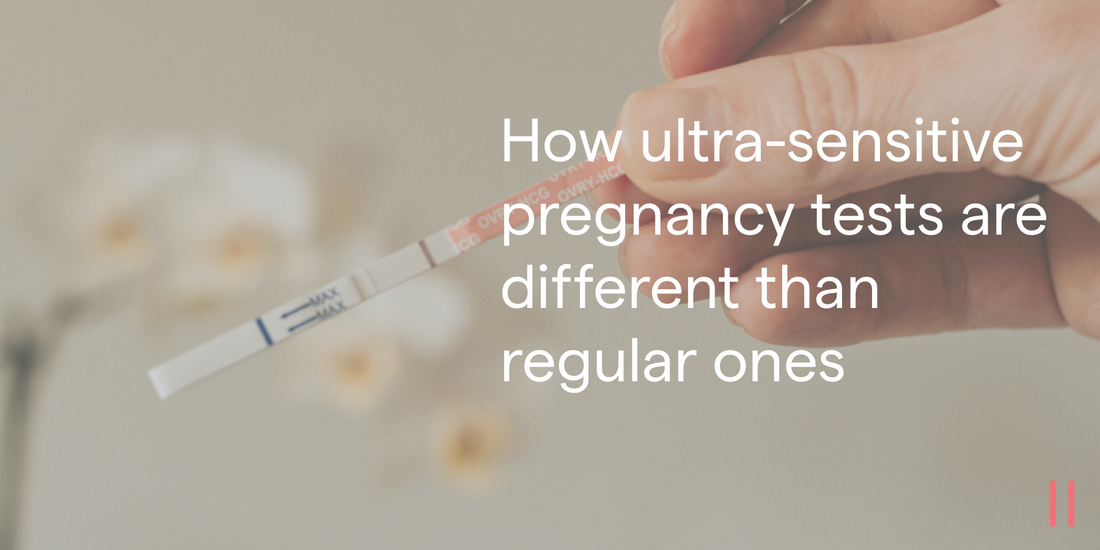Everything we do today is highspeed: our internet connection, fast food and even fast fashion. We’ve come to acquire a certain sense of urgency when it comes to, well, everything. The need for speed has also extended to pregnancy tests, which are made to detect pregnancies earlier and earlier. And even though ultra-sensitive tests are useful in so many ways, it’s important to understand how they differ from regular tests. Here’s what you need to know.
They can detect chemical pregnancies & be triggered by certain fertility treatments
As we describe here, a chemical pregnancy is a kind of early miscarriage that can result in a positive pregnancy test. A chemical pregnancy occurs when an egg is fertilized but doesn’t implant successfully into the uterus, and therefore does not become a viable pregnancy. In many cases, those experiencing a chemical pregnancy might not even know, since they get their period around the same time that it’s expected. However, if you’re using an ultra-sensitive pregnancy test before the date of your expected period, and the test result is positive, it is possible that the test is detecting a chemical pregnancy.
Chemical pregnancies are not an indication that you cannot get pregnant. However, if you are trying to conceive and experience recurrent chemical pregnancies, it may be worth checking in with your doctor. If you’re struggling, you should also consider speaking to a mental health professional or finding a support group. (We have some resources for you in this article.)
Trigger shots, which are often used to stimulate ovulation during fertility treatments such as IVF, IUI or embryo transfers, can also be detected by ultra-sensitive pregnancy tests like Ovry's if the testing is done too early. For this reason, it is recommended that those undergoing fertility treatments of any kind, rely on blood tests from their physician or wait until at least 14 DPO to use a home pregnancy test.
If testing early, one test might not be enough
It’s crucial when taking an ultra-sensitive pregnancy test, especially before your expected period, to take another test two days later to confirm the results. At Ovry, we make those instructions clear in each of our kits and it’s also why we include several tests per box. Like all leading pregnancy test brands, the accuracy rates - which in our case is over 99.7% - are all from the date of your expected period. So the later you test, the more accurate your results.
Lower detection threshold = higher sensitivity
Most sensitive hCG pregnancy tests are qualitative, meaning they give negative/positive results. In order to do so, they detect Human Chorionic Gonadotropin or hCG, which is detectable in urine in the early days of pregnancy.
“An hCG level of less than 5 mIU/mL is considered negative for pregnancy, and anything above 25 mIU/mL is considered positive for pregnancy,” according to the American Pregnancy Association. However, ultra-sensitive tests, like Ovry’s, can detect pregnancy at 10 mIU/mL. In fact, Ovry is one of the only brands of strip-format pregnancy tests that offers this level of sensitivity.
The benefit of using an ultra-sensitive test is that you can find out if you’re pregnant up to four days sooner than you would if you were using most store bought midstream tests, a 2014 report found. The same report warned that the users should be selective when picking which test to use. False claims and promises are made as marketing ploys to attract buyers. The report suggests using tests that are compliant with regulatory requirements, such as those set by the FDA or Health Canada, (which, of course, all Ovry tests are!) and to make sure that users read the instructions fully.
When used properly, ultra-sensitive tests can be a great way to find peace of mind by detecting pregnancy ASAP (#AsSoonAsPissible). And if you’re like us and you live life in the fast lane, it’s a great option to keep on the shelf of your medicine cabinet.

